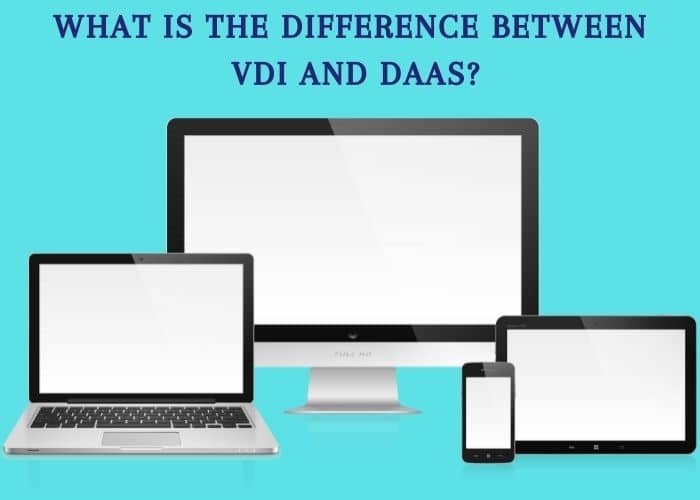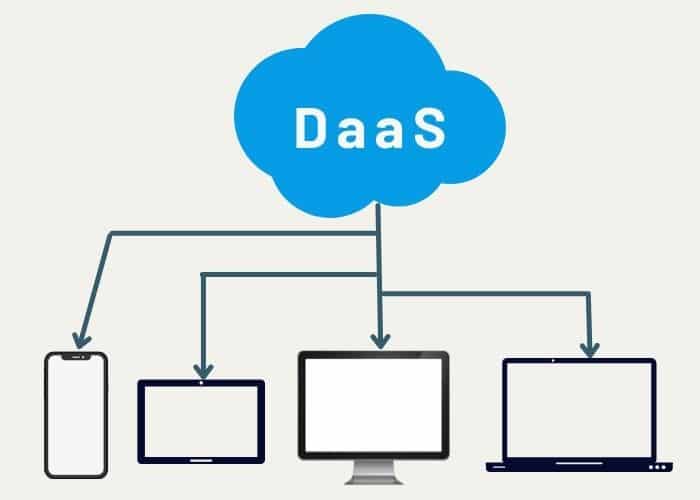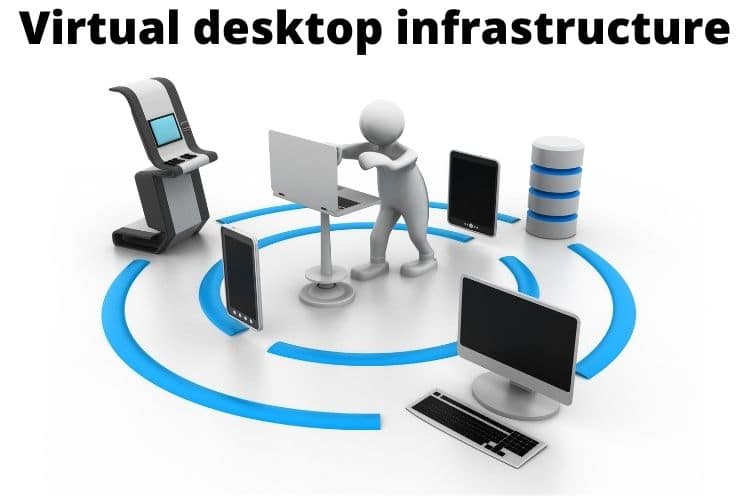
What is Virtual Desktop Infrastructure (VDI)?
VDI technology abbreviated as Virtual Desktop Infrastructure enables you to host desktop OS virtually in On-premise servers or in the cloud servers. To understand what is VDI? we need to understand the concept of virtualization. Virtualization gives end-users the power to access OS, software, etc via the internet from any remote location.
Several virtual machines are deployed over the servers and made available for the use of their customers. This technology is also known as end-user computing (EUC).

What is Desktop as a Service (DaaS)?
DaaS services are similar to VDI but are hosted on the cloud server. Let us discuss what is DaaS on-premise in more detail. The hardware, maintenance, security, and updating everything related to DaaS is the responsibility of the cloud vendor. The remote desktop here is deployed on the cloud infrastructure which enables users to access other cloud services long with DaaS service.
The billing of all the services is based on subscriptions.Despite the greater attractions of Desktop As A Service, it might not be the ideal solution for your business problems. Let us evaluate both VDI and DaaS over various parameters to understand their true potentials
What is the difference between VDI and DaaS?
1. Single-tenant vs. Multi-tenant
VDI deployments are single-tenant models where only a single user can use the hosted desktop environment. The single user can be an entire organization with multiple desktops. The main aim of single-tenant is to have complete control over the hardware and network infrastructure of the organization.
DaaS deployment is a multi-tenant model where different groups of people buy/rent services provided by the cloud provider. The service is the same for all the users except for the fact that they are virtually separate from each other. Here the control of hardware, servers, etc stays with the provider and virtual desktops can be accessed via portals.
2. Platform
In VDI, the complete ownership of the network is of the organization if the servers are hosted on-premise. The server maintenance, update, secure network services check is the organization’s responsibility. On-premise hosting is not dependent on the internet and can function without its presence.
If the server is hosted on a private cloud server, the cloud service provider is responsible for server maintenance. The control plane of network infrastructure is in the hand of providers. Private-cloud hosting is internet-dependent.
In DaaS technology, the software, security, and server update are on a weekly basis. The cloud environment is quite flexible for users. The catch in DaaS is that it is majorly dependent on the internet, if the internet goes down the workflow gets interrupted.
3. Cost
Cost is one of the major factors when it comes to business optimization. So let us look at the cost expenditure of both VDI and DaaS.
VDI is a self-managed virtual hosting of desktops. It requires a hefty investment in the initial phase of the business. The investment includes the capital expense for servers, physical space to set up servers, IT team to configure and manage, power supply, cooling technology, and the list go on.
Whereas in DaaSservers, infrastructure, etc are already maintained by the cloud providers. You pay only for the services you use along with DaaS. The flexible consumption model enables users to pay monthly, quarterly, or yearly depending on the subscription plans and the services used.
The drawback here is first the servers are not permanently yours so the cost is a recurring cost. Second, there are multiple cloud providers and their subscription plans can be hefty if not chosen with proper guidance. Unlike others, Scalebuzz is one of the best cloud solution providers that too at effective rates.
4. Control
Your organization has complete control of the VDI servers hosted on-premise. With the additional work of maintenance, network configuration, security check, regular updates, etc.
In DaaS, the control is in the cloud provider’s hand along with the responsibilities of maintenance, regular updates, and high-encrypted security.
5. Agility and Elasticity
In on-premise vdi setting up working is a tedious task and can be time-consuming. This makes VDI less flexible to try out other OS, and system settings. Since the servers are limited, to scale the system more servers are to be purchased and the whole process of configuration is to be repeated.
On the other hand, DaaS provides you with a more flexible environment to work with. Since the services are already ready to use servers can spin up and down whenever required. The need to purchase new hardware is eliminated you only need to pay the subscription costs for the services used.
6. Organization Capability
VDI platforms need their own IT skilled staff to configure and manage the servers, network, security, etc of the system. In DaaS, all the end-user computing is taken care of by the cloud service provider. They are responsible for any malware or network error in the system.
7. Geography
The DaaS model is available all over the globe. This enables you to configure your virtual machines and data centers near your end-users location. This in return decreases the latency and response time to your virtual applications and desktops. But on the contrary, VDI is restricted to a particular location or region, scaling their access outside the network might not be possible virtually.
8. Security
Organizations with highly critical and sensitive data opt for on-site VDI. They prefer to keep complete control of the system and its backend to provide high-end security to the data. In Daas, the data is highly-encrypted and enabled with multi-factor to provide high security.
9. Data Backup
The VDI solution to data backup is the deployment of additional data servers. These servers are either on-premise or in some external network. In DaaS, the data backup is an automated process and at regular intervals. The reason behind data backup is to maintain business continuity.
10. Access to resources
VDI operates on a single-tenant model so your resources are not shared by any other organizations or networks. The server is solely dedicated to your work. Since there are no other users the point of other users’ server demand is irrelevant. The failure of servers or datacenters can affect the continuity of your business.
DallaS operates on a Multi-tenant model. Here the virtual resources are shared dynamically. The request of high-priority users can interfere with your access to certain resources.

Pros and Cons of Virtual Desktop Infrastructure
Let us have a look at the pros and cons of virtual desktop infrastructure.
Pros of VDI:
- Complete control over the hardware and infrastructure.
- Customized high-level security protection.
- The resources are completely dedicated to your virtual desktops.
Cons of VDI:
- Applications cannot be deployed globally
- The upfront expense on hardware, etc makes it less cost-effective.
- Requirement of skilled IT labor.
Pros and Cons of Desktop as a Service
Pros of DaaS:
- Highly cost-effective
- Scalable and agile model
- High-encrypted security with multi-factor authentication.
- Managed by the cloud provider
- No need for desktops in-house infrastructure.
Cons of DaaS:
- The cost incurred is a recurring cost as it is based on the subscription model.
- Lack of cloud knowledge can lead to a hefty bill amount.
The control of the environment is less when compared with on-premise infrastructure.
DaaS vs.VDI: Use cases
Some of the commons use cases for DaaS and VDI are:
- Workforce: In Daas, it is easy to scale up or down the resources as and when required.
- Expansion: Companies can focus on Expanding the workforce in the direction of growing their business in multiple territories.
- Business continuity: Having datacenters hosted on cloud infrastructure. The data can be accessed anywhere anytime with minimal downtime.
- Predictable IT expenses: Cloud solutions are subscription-based. Thus, the expenses spent on the services are predictable and cost-effective.
Mergers and acquisitions: It can be carefully handled by DaaS by provisioning equal distribution of resources.
Conclusion
Both VDI and DaaS are highly scalable solutions. They provide their user with a high-performance desktop experience. But to select the best from both VDI and DaaS you need to analyze your business needs on various parameters.
The type of business you are into, workforce strength, time duration, type of data, and of course budget are above all others. If your enterprise contains a large workforce VDI would be a wise option. Whereas, DaaS is more feasible for small-cap and mid-cap enterprises.
FAQ
Is the DaaS revolution upon us?
The revolution of DaaS is slower when compared with other cloud services. But with the increase in infrastructure, software, and agile computing needs organizations have started to shift from VDI’s to DAAS.
Should I wait to invest in DaaS?
DaaS is based on subscription plans and can be a feasible solution for small and mid-cap companies. The initial cost of DaaS is recurring and cheap. So if you don’t want to invest in a server at the beginning phase DaaS can be a good choice to go for.

